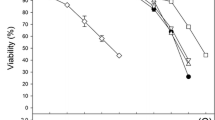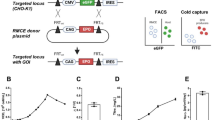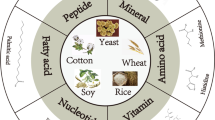Abstract
Yeast extract (YE), as a non-animal source additive for mammalian cell culture medium, has been widely used for manufacturing of therapeutic proteins. In the present study, one particular YE was found to have significantly improved the specific productivity (q p) of Fc-fusion protein in recombinant Chinese hamster ovary (rCHO) cell culture. In order to elucidate the intracellular effects of YE on protein productivity, steps of the target protein synthesis process were investigated to unveil their variations caused by YE addition. Stepwise analysis on Fc-fusion protein synthesis process showed that YE enhanced Fc-fusion protein gene transcription with cell cycle arrest at G1 phase; mammalian target of rapamycin (mTOR) signaling pathway was activated to enhance the translation of Fc-fusion protein, and the block in post-translational steps of Fc-fusion protein was alleviated by YE addition as well. Our results revealed the responses of multiple protein production steps to the addition of YE and provided a practical guidance for the separation and application of active compounds from hydrolysates.







Similar content being viewed by others
References
Aggarwal SR (2014) What’s fueling the biotech engine—2012 to 2013. Nat Biotechnol 32:32–39
Allen MJ, Boyce JP, Trentalange MT, Treiber DL, Rasmussen B, Tillotson B, Davis R, Reddy P (2008) Identification of novel small molecule enhancers of protein production by cultured mammalian cells. Biotechnol Bioeng 100(6):1193–1204
Becker E, Florin L, Pfizenmaier K, Kaufmann H (2008) An XBP-1 dependent bottle-neck in production of IgG subtype antibodies in chemically defined serum-free Chinese hamster ovary (CHO) fed-batch processes. J Biotechnol 135(2):217–223
Buchner J, Pastan I, Brinkmann U (1992) A method for increasing the yield of properly folded recombinant fusion proteins: single-chain immunotoxins from renaturation of bacterial inclusion bodies. Anal Biochem 205(2):263–270
Burdakov D, Petersen OH, Verkhratsky A (2005) Intraluminal calcium as a primary regulator of endoplasmic reticulum function. Cell Calcium 38(3):303–310
Chen F, Fan L, Wang J, Zhou Y, Ye Z, Zhao L, Tan WS (2012) Insight into the roles of hypoxanthine and thymidine on cultivating antibody-producing CHO cells: cell growth, antibody production and long-term stability. Appl Microbiol Biotechnol 93(1):169–178
Dreesen IA, Fussenegger M (2011) Ectopic expression of human mTOR increases viability, robustness, cell size, proliferation, and antibody production of Chinese hamster ovary cells. Biotechnol Bioeng 108(4):853–866
Du Z, Treiber D, McCarter JD, Fomina-Yadlin D, Saleem RA, McCoy RE, Zhang Y, Tharmalingam T, Leith M, Follstad BD, Dell B, Grisim B, Zupke C, Heath C, Morris AE, Reddy P (2015) Use of a small molecule cell cycle inhibitor to control cell growth and improve specific productivity and product quality of recombinant proteins in CHO cell cultures. Biotechnol Bioeng 112(1):141–155
Florin L, Pegel A, Becker E, Hausser A, Olayioye MA, Kaufmann H (2009) Heterologous expression of the lipid transfer protein CERT increases therapeutic protein productivity of mammalian cells. J Biotechnol 141(1):84–90
Franěk F, Katinger H (2002) Specific effects of synthetic oligopeptides on cultured animal cells. Biotechnol Prog 18(1):155–158
Franěk F, Hohenwarter O, Katinger H (2000) Plant protein hydrolysates: preparation of defined peptide fractions promoting growth and production in animal cells cultures. Biotechnol Prog 16(5):688–692
Gupta AJ, Hageman JA, Wierenga PA, Boots J-W, Gruppen H (2014) Chemometric analysis of soy protein hydrolysates used in animal cell culture for IgG production—an untargeted metabolomics approach. Process Biochem 49(2):309–317
Hendrick V, Winnepenninckx P, Abdelkafi C, Vandeputte O, Cherlet M, Marique T, Renemann G, Loa A, Kretzmer G, Werenne J (2001) Increased productivity of recombinant tissular plasminogen activator (t-PA) by butyrate and shift of temperature: a cell cycle phases analysis. Cytotechnology 36(1-3):71–83
Jiang Z, Sharfstein ST (2008) Sodium butyrate stimulates monoclonal antibody over-expression in CHO cells by improving gene accessibility. Biotechnol Bioeng 100(1):189–194
Kou TC, Fan L, Zhou Y, Ye ZY, Liu XP, Zhao L, Tan WS (2011) Detailed understanding of enhanced specific productivity in Chinese hamster ovary cells at low culture temperature. J Biosci Bioeng 111(3):365–369
Kumar N, Gammell P, Clynes M (2007) Proliferation control strategies to improve productivity and survival during CHO based production culture. Cytotechnology 53(1-3):33–46
Lee CJ, Seth G, Tsukuda J, Hamilton RW (2009) A clone screening method using mRNA levels to determine specific productivity and product quality for monoclonal antibodies. Biotechnol Bioeng 102(4):1107–1118
Lee HW, Christie A, Starkey JA, Read EK, Yoon S (2014) Intracellular metabolic flux analysis of CHO cells supplemented with wheat hydrolysates for improved mAb production and cell-growth. J Chem Technol Biotechnol 90(2):291–302
Li B, Sirimuthu NMS, Ray BH, Ryder AG (2012) Using surface-enhanced Raman scattering (SERS) and fluorescence spectroscopy for screening yeast extracts, a complex component of cell culture media. J Raman Spectrosc 43(8):1074–1082
Liu C-H, Chu I-M, Hwang S-M (2001) Pentanoic acid, a novel protein synthesis stimulant for Chinese hamster ovary (CHO) cells. J Biosci Bioeng 91(1):71–75
Lu C, Gonzalez C, Gleason J, Gangi J, Yang JD (2007) A T-flask based screening platform for evaluating and identifying plant hydrolysates for a fed-batch cell culture process. Cytotechnology 55(1):15–29
Ma XM, Blenis J (2009) Molecular mechanisms of mTOR-mediated translational control. Nat Rev Mol Cell Biol 10(5):307–318
Mendonca RZ, de Oliveira EC, Pereira CA, Lebrun I (2007) Effect of bioactive peptides isolated from yeastolate, lactalbumin and NZCase in the insect cell growth. Bioprocess Biosyst Eng 30(3):157–164
Michiels JF, Barbau J, De Boel S, Dessy S, Agathos SN, Schneider YJ (2011) Characterisation of beneficial and detrimental effects of a soy peptone, as an additive for CHO cell cultivation. Process Biochem 46(3):671–681
Mosser M, Kapel R, Aymes A, Bonanno L-M, Olmos E, Chevalot I, Marc I, Marc A (2012) Chromatographic fractionation of yeast extract: a strategy to identify physicochemical properties of compounds promoting CHO cell culture. Process Biochem 47(7):1178–1185
Mosser M, Chevalot I, Olmos E, Blanchard F, Kapel R, Oriol E, Marc I, Marc A (2013) Combination of yeast hydrolysates to improve CHO cell growth and IgG production. Cytotechnology 65(4):629–641
Nyberg GB, Balcarcel RR, Follstad BD, Stephanopoulos G, Wang DI (1999) Metabolism of peptide amino acids by Chinese hamster ovary cells grown in a complex medium. Biotechnol Bioeng 62(3):324–335
Oslowski CM, Urano F (2011) Measuring ER stress and the unfolded protein response using mammalian tissue culture system. Method Enzymol 490:71–92
Proud CG (2009) mTORC1 signalling and mRNA translation. Biochem Soc Trans 37(1):227–231
Richardson J, Shah B, Bondarenko PV, Bhebe P, Zhang Z, Nicklaus M, Kombe MC (2015) Metabolomics analysis of soy hydrolysates for the identification of productivity markers of mammalian cells for manufacturing therapeutic proteins. Biotechnol Prog. doi:10.1002/btpr.2050
Royle L, Campbell MP, Radcliffe CM, White DM, Harvey DJ, Abrahams JL, Kim Y-G, Henry GW, Shadick NA, Weinblatt ME (2008) HPLC-based analysis of serum N-glycans on a 96-well plate platform with dedicated database software. Anal Biochem 376(1):1–12
Ruggero D, Sonenberg N (2005) The Akt of translational control. Oncogene 24(50):7426–7434
Schlatter S, Senn C, Fussenegger M (2003) Modulation of translation-initiation in CHO-K1 cells by rapamycin-induced heterodimerization of engineered eIF4G fusion proteins. Biotechnol Bioeng 83(2):210–225
Schmittgen TD, Livak KJ (2008) Analyzing real-time PCR data by the comparative CT method. Nat Protoc 3(6):1101–1108
Sengupta S, Peterson TR, Sabatini DM (2010) Regulation of the mTOR complex 1 pathway by nutrients, growth factors, and stress. Mol Cell 40(2):310–322
Shen AY, Van de Goor J, Zheng L, Reyes AE, Krummen LA, Ozturk S, Hu W (2006) Recombinant DNA technology and cell line development. Biotechnol Biprocess Ser 30:15–40
Sommer R (1998) Yeast extracts: production, properties and components. Food Aust 50(4):181–183
Sung YH, Lim SW, Chung JY, Lee GM (2004) Yeast hydrolysate as a low-cost additive to serum-free medium for the production of human thrombopoietin in suspension cultures of Chinese hamster ovary cells. Appl Microbiol Biotechnol 63(5):527–536
Sunley K, Butler M (2010) Strategies for the enhancement of recombinant protein production from mammalian cells by growth arrest. Biotechnol Adv 28(3):385–394
Svennerholm L (1957) Quantitive estimation of sialic acids: II. A colorimetric resorcinol-hydrochloric acid method. Biochim Biophys Acta 24:604–611
Wilkins J, Shiratori MK, Breece T (2009) Biologically active c-terminal arginine-containing peptides. United States Patent. US 2009/0143248 A1
Yang WC, Lu J, Nguyen NB, Zhang A, Healy NV, Kshirsagar R, Ryll T, Huang YM (2014) Addition of valproic acid to CHO cell fed-batch cultures improves monoclonal antibody titers. Mol Biotechnol 56(5):421–428
Yoon SK, Song JY, Lee GM (2003) Effect of low culture temperature on specific productivity, transcription level, and heterogeneity of erythropoietin in Chinese hamster ovary cells. Biotechnol Bioeng 82(3):289–298
Yu M, Hu Z, Pacis E, Vijayasankaran N, Shen A, Li F (2011) Understanding the intracellular effect of enhanced nutrient feeding toward high titer antibody production process. Biotechnol Bioeng 108(5):1078–1088
Acknowledgments
This work was supported by the National Natural Science Foundation of China (Nos. 21206040 and 21406066), the National Science and Technology Major Project (No. 2013ZX10004003-003-003), and the National High Technology Research and Development Program of China (863 Program) (No. 2012AA02A303).
Conflict of interest
The authors declare that they have no competing interests.
Author information
Authors and Affiliations
Corresponding authors
Electronic supplementary material
Below is the link to the electronic supplementary material.
ESM 1
(PDF 112 kb)
Rights and permissions
About this article
Cite this article
Hu, D., Sun, Y., Liu, X. et al. Understanding the intracellular effects of yeast extract on the enhancement of Fc-fusion protein production in Chinese hamster ovary cell culture. Appl Microbiol Biotechnol 99, 8429–8440 (2015). https://doi.org/10.1007/s00253-015-6789-5
Received:
Revised:
Accepted:
Published:
Issue Date:
DOI: https://doi.org/10.1007/s00253-015-6789-5




